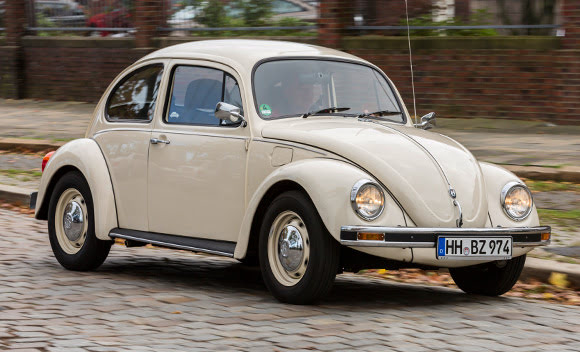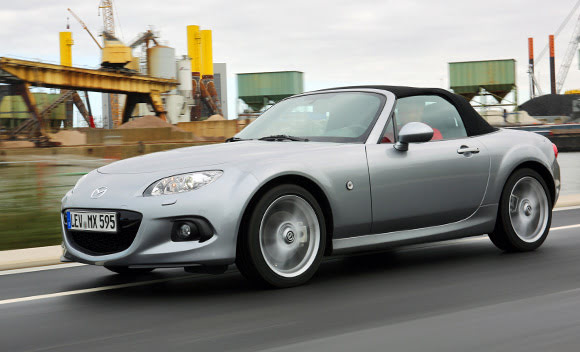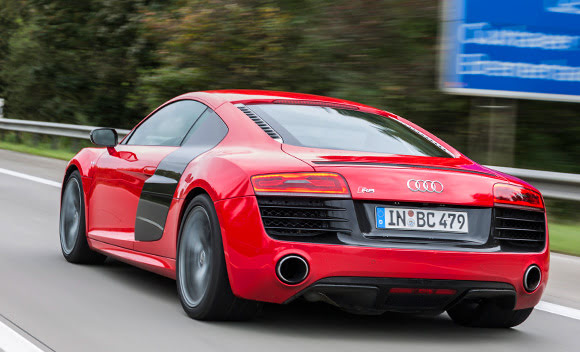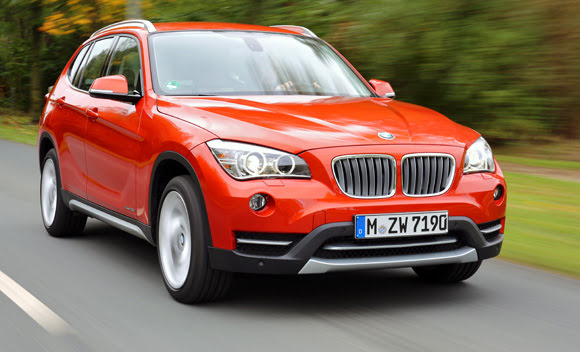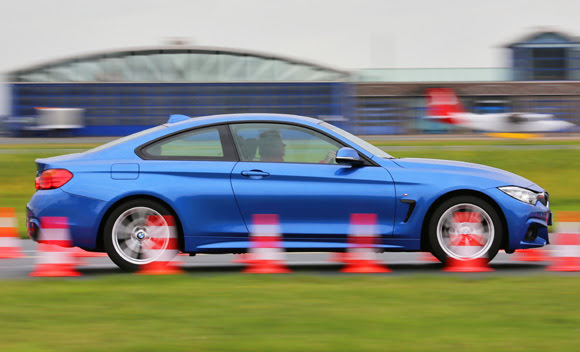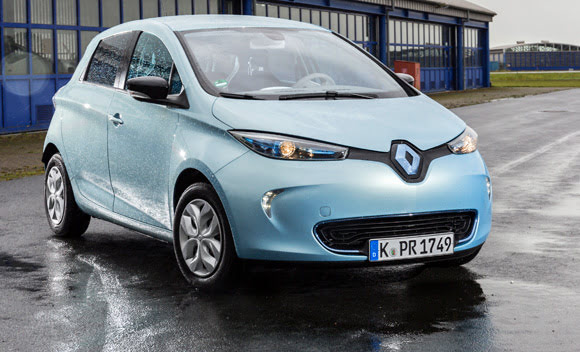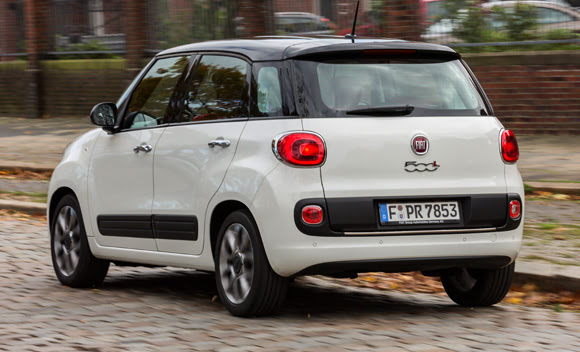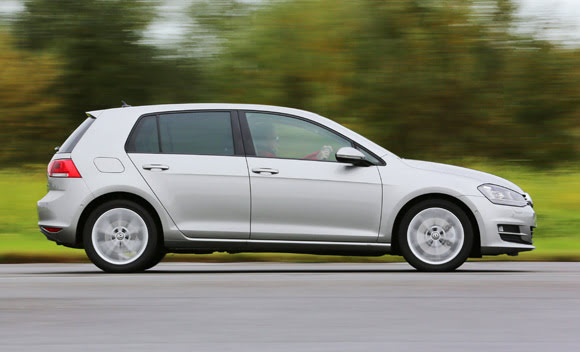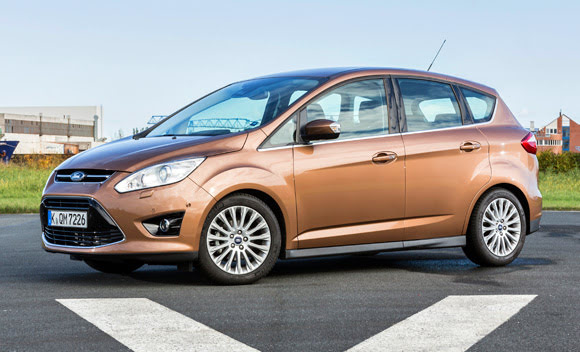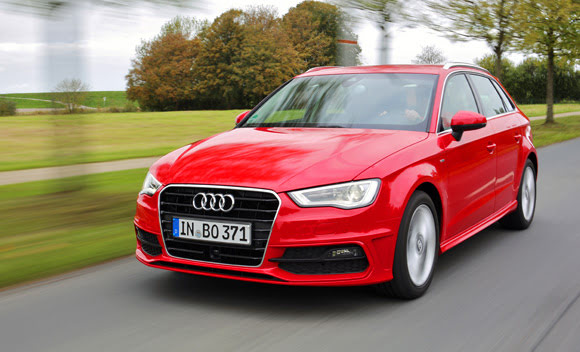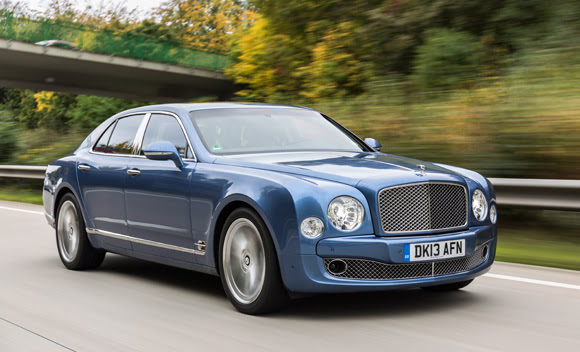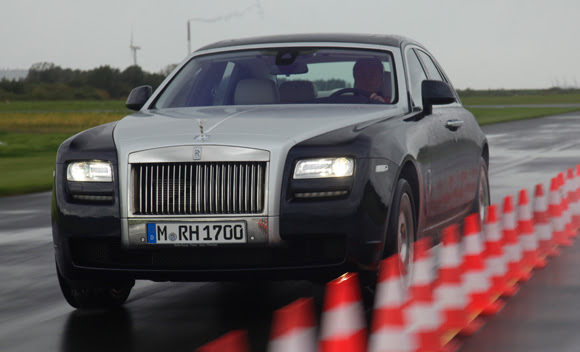The rear of the engine compartment knocks, squeaks and rattles. The wind noise rushes and hisses over the side windows, intensifying as the car accelerates. Metal panels tremble, tyres rumble, gears grind and parts of the trim squeak and rattle – all resulting in an unearthly cacophony of noise.
Without a doubt, a drive in the good old VW Beetle provides a lot of aural input. Yes, it really is noisy in this classic bug from Wolfsburg.
Luckily, things have changed since then. Engines are quieter and car bodies are better insulated. Most cars are only noisy at high speeds or during acceleration when the engine roars into life. And that’s when a grumpy diesel engine will become even more annoying. Just as the speed increases, the noise mix produced by the tyres, chassis and wind intensifies.
The Quietest Car
SONE
The unit of perceived loudness.
AUTO BILD tested 14 current car models to see how noisy a car can get in unfavourable conditions. The 14 cars ranged from the quiet, represented by the ultimate example – the Rolls-Royce Ghost, and the almost soundless electric car, to their complete antithesis – the Audi R8 V10 supercar. The noise the 14 cars produced was not only measured in the usual decibels, more precisely dB(A), but also captured in sones. In contrast to the decibel, which only measures the physically detected sound, the sone provides a more realistic evaluation of how humans experience noise.
The system used for the test measures sound with amazing accuracy. For example, it is capable of differentiating between noise produced by tyres, wind and the engine. Even the difference between sitting close to the window or in the centre of the car is filtered out by the software used. It is even possible to measure speech intelligibility. During the test, the system could identify which specific sounds could affect the degree to which speech could be understood.
The results collected from the seven measured parameters were summarised and evaluated using a points system. And with every car given an overall mark, the quietest car was found.
Here’s a clue – it wasn’t the VW Beetle!
How the testing was performed
The tests were carried out by German magazine AUTO BILD in cooperation with Brüel & Kjær. As part of their luggage, the two engineers had brought with them the latest measuring equipment, specially designed for use in passenger cars. The Head And Torso Simulator (HATS) is placed in the front (or rear) of the vehicle, and picks up noises via microphones inside its head. In addition, a binaural headset was used, allowing one of the engineers to listen to the recordings. Both systems were connected via WLAN to a tablet PC, making it easy to monitor the measurements during the test drive.
A prerequisite for an accurate measurement is the avoidance of unnecessary noise, so loose objects such as pens or key chains were not allowed in the test car. Each test run was carried out on the AUTO BILD test track in Bremerhaven by a test driver and an engineer.
How the points were awarded
The conclusion was the combined results of seven test events of different weighting. The inner sound (front of car) was measured for all candidates. In the case of constant speed driving, the average value of the results at speeds of 50, 100 and 130 km/h were evaluated. In the case of the zero to 100 km/h acceleration, the highest measurable value (peak) was evaluated. AUTO BILD determined the top speed results on the autobahn (German motorway).
Speech intelligibility was judged on how well passengers managed to understand each other on the autobahn at a speed of 130 km/h. For many participants, this was not a problem. In fact, the only time a conversation was virtually impossible at high speeds was during the extremely noisy VW Beetle test drives. While measuring the auditory perception parameters, the subjective noise perceived for the 14 candidates throughout the entire test was assessed. Here, sound quality was the most important parameter.
In the end, AUTO BILD preferred the V8 sound range of the Bentley to the V12 whisper of the Rolls Royce.
The result
Precision microphones, sophisticated measuring software and attentive tester ears hear everything. Or too little, as in the case of the winner – the Mercedes S 500. The limousine marks the lower end of the current noise threshold when driving – it was even quieter than the Rolls Royce. The electric cars showed that a silent motor alone is no guarantee for in-car comfort – noise is also generated by wind and tyres.
Ten questions about noise in cars
Does the dull nailing of a diesel compared to the clear sound of a petrol engine just sound louder or is that really true? We asked ourselves these and other questions – and immediately measured again.
1) Do bigger wheels roll louder?
Hardly! An experiment with an Audi A3 showed that when the tyre size was increased from 225/45 R 17 to the next larger variant 225/40 R 18, the road noise only increased by half a sone. This is hardly audible.
2) Is a four-cylinder louder than a six-cylinder?
Yes! Under load (when accelerating from zero to 100) a BMW 435i (with a 3.0 litre six-cylinder petrol engine), for example, measures nearly 30 sone, whereas we measured 1.5 sones more with a 428i with the 2.0 litre, four-cylinder engine. One reason, of course, is the power deficit with corresponding consequences for the transmission layout, and the different rev levels.
3) Is a convertible with a fabric roof louder than one with a steel roof?
Yes! A comparison of high-speed cruises shows that the fabric roof makes about twice as much noise as a fixed roof. More precisely, the MX-5 with cloth cap produces 105.3 sones, its brother with a retractable roof only 80.4 sones.
4) Is a convertible with open roof louder?
Yes! The moment the retractable roof is open, the wind noise increases dramatically. We could establish up to 18 sones difference.
5) Is a petrol engine quieter than a diesel engine?
No! At least for the Golf the following applies – a TDI behaves with more restraint during sprinting with the accelerator pedal completely depressed than its equivalent with a TSI engine. The latter achieved higher revs but resulted in more noise.
6) Can you hear the engine at a speed of 100?
Yes! For this example, we once again picked the Golf 2.0 TDI – its motor hums quite audibly at this speed. Only at 130 km/h and above do the wind and tyre noise drown out the TDI growl.
7) Is a station wagon louder than a sedan?
Yes! An Audi A3 Sportback (at a constant measured speed of 100) is actually a bit louder than the identical A3 with a boot. In fact, there is only 1.4 sones difference between the Sportback and the notchback.
8) Is the Rolls quieter at the back than in the front?
Yes! The quietest place in the Rolls-Royce Ghost (at a speed of 100) is at the rear to the right, even if the driver, strictly speaking, has to endure more noise – a difference of 0.9 sones. Only very sensitive people are likely to detect this.
9) Is the rear shelf important?
No! If there is no plate behind the rear-seat backrest, then you might think that one sound absorbing element is missing. As far as the Audi A3 Sportback is concerned, there is no measurable difference with and without the cover.
10) Does one really only hear the clock in the Rolls-Royce?
No! The clock is silent. If you can hear something, it’ll be the V12 and the ventilation.
NVH - NOISE, VIBRATION, AND HARSHNESS
14th place
VW Beetle Última Edición: It crawls into your ear
Even when stationary, you can hear a rumble from the engine compartment. Once it gets going, the noise increases dramatically. The air-cooled engine, which lacks a noise-insulating layer of cooling radiator water, howls with noise from the fan. It feels as if every rotation and every power stroke penetrates into the interior. At a speed of 130, one is no longer able to communicate with the front-seat passenger. And on cobblestones, this crawler roars uninhibitedly.
Driving at a constant speed (at 50, 100, 130 km/h): 24.59 / 45.16 / 56.2 sone* Acceleration (0–100 km/h): 51.24 sone Top speed: 71.66 sone Cobblestones (at 40 km/h): 53.66 sone Interior noise (stationary and idling): 14.51 sone Auditory perception (subjective score for noise type): Score 5+ Speech intelligibility (determined at 130 km/h): Score 6* Sone is the unit of perceived loudness
Technical data
- Four-cylinder boxer, rear-mounted
- Capacity 34 kW (46 hp) at 4100/min
- Vredestein T-Trac tyres
- 165/80 R 15 T
- Acceleration 0-100 km/h in 22.5 s
- top speed 130 km/h
Conclusion The Beetle makes us aware how quietly modern cars purr and, in 2013, it can only survive among its fans.
Score: 5+
13th place Mazda MX-5 Roadster: Open to noise
The roof, consisting of thin layers of fabric, doesn’t seem to protect from any environmental noise. Therefore, the noise of driving invades the car without filter. Moreover, the fabric roof produces annoyingly loud wind turbulence at high speed. The engine is also unpleasantly noisy when accelerating and under appropriate load. There is very little insulation material under the bonnet, inviting the engine to distribute plenty of noise at high speed. As a result, the overall noise levels are very high.
Driving at a constant speed (at 50, 100, 130 km/h): 19.91 / 32.84 / 48.32 sone* Acceleration (0–100 km/h): 48.44 sone Top speed: 105.27 sone Cobblestones (at 40 km/h): 47.64 sone Interior noise (stationary and idling): 6.39 sone Auditory perception (subjective score for noise type): Score 4+ Speech intelligibility (determined at 130 km/h): Score 5+* Sone is the unit of perceived loudness
Technical data
- Four-cylinder boxer, front-mounted
- Capacity 118 kW (160 hp) at 7000 rpm
- Bridgestone Potenza RE 050 A tyres
- 205/45 R 17 W
- Acceleration 0-100 km/h in 7.9 s
- top speed 213 km/h
Conclusion The flimsy roof, a rough engine and hardly any insulation under the bonnet cause plenty of unpleasant noise in this Roadster.
Score: 4
12th place Audi R8 V10 FSI: You'll hear it soon enough
When driving at constant speed, the 525 HP Audi is barely louder than the electric car, Zoe. Can this be something to do with faulty hearing? No, the measurement at a speed of 130 shows that the Audi rumbles discreetly at this speed with comfortably low revolutions per minute, while the Zoe irritates with loud rolling noises. But, it’s a totally different story when the driver calls on the mighty V10 behind the seats. During acceleration, the engine roars loudly at Vmax – 314 km/h – so loud that it almost hurts your ears.
Driving at a constant speed (at 50, 100, 130 km/h): 17.35 / 25.60 / 33.91 sone* Acceleration (0–100 km/h): 61.91 sone Top speed: 114.70 sone Cobblestones (at 40 km/h): 54.84 sone Interior noise (stationary and idling): 7.74 sone Auditory perception (subjective score for noise type): Score 4- Speech intelligibility (determined at 130 km/h): Score 2-* Sone is the unit of perceived loudness
Technical data
- V-10, rear-mounted
- Capacity 386 kW (525 hp) at 8000 rpm
- Pirelli P Zero tyres
- v./h. 235/35 – 305/30 ZR 19 Y
- Acceleration 0-100 km/h in 3.6 s
- top speed 314 km/h
Conclusion As can be expected, the V10 sounds sporty – but it’s also loud. In addition, the tyre and wind noise are very prominent at high speed.
Score: 4
11th Place BMW X1: Constant growling
Despite abundant insulation under the bonnet and full enclosure of the common rail diesel engine, the two-litre, four-cylinder growls audibly in every situation. Nevertheless, it is never blatantly noisy. The tyres always roll along audibly, but on cobblestones, the noise is inconspicuous. The quality of speech intelligibility when speeding at 130 is only moderate since the engine, to a large degree, drowns conversation between passengers.
Driving at a constant speed (at 50, 100, 130 km/h): 12.66 / 21.41 / 29.97 sone* Acceleration (0–100 km/h): 22.08 sone Top speed: 59.84 sone Cobblestones (at 40 km/h): 33.06 sone Interior noise (stationary and idling): 5.38 sone Auditory perception (subjective score for noise type): Score 3 Speech intelligibility (determined at 130 km/h): Score 3
* Sone is the unit of perceived loudness
Technical data
- Four-cylinder, turbo, front-mounted
- Capacity 105 kW (143 hp) at 4000 rpm
- Pirelli Cinturato P 7 tyres
- 225 / 45 R 18 Y
- Acceleration 0-100 km/h in 9.6 s
- top speed 200 km/h
Conclusion The noise of the running engine is always present, but it’s not unbearably loud. Apart from that, the X1 performs in keeping with its class.
Score: 3+
10th place BMW 4 series: The engine struggles
The Coupé rolls gently despite its wide tyres, but quietly because of them. The four-cylinder turbo engine also runs like velvet and is suitably restrained. However, when full-throttle is launched, the noise levels rise accordingly. Even though the engine sounds lusciously sporty, the volume is higher than, for example, that of the Fiat 500L. At a top speed of 250 km/h, the wind roars fiercely.
Driving at a constant speed (at 50, 100, 130 km/h): 11.35 / 18.16 / 24.48 sone* Acceleration (0–100 km/h): 29.94 sone Top speed: 61.42 sone Cobblestones (at 40 km/h): 31.95 sone Interior noise (stationary and idling): 3.82 sone Auditory perception (subjective score for noise type): Score 3 Speech intelligibility (determined at 130 km/h): Score 1-* Sone is the unit of perceived loudness
Technical data
- Four-cylinder, turbo, front-mounted
- Capacity 180 kW (245 hp) at 5000 rpm
- Bridgestone Potenza S001 tyres
- 225 / 45-255 / 40 R 18 Y
- Acceleration 0-100 km/h in 5.8 s
- top speed 250 km/h
Conclusion When performance is required, the four-cylinder responds noisily. Otherwise, the 4 series rolls along calmly.
Score: 2-
9th place Renault Zoe: Chirps very gently
At 60 km/h, the typical sound of an electric engine, more commonly associated with a tram, mingles with wind noise. You can also clearly hear loose chippings being hurled by the tyres into the wheel wells. The good result at maximum speed is easy to explain – the 88 HP electric drive only accelerates the little Frenchman to a maximum of 135 km/h.
Driving at a constant speed (at 50, 100, 130 km/h): 11.84 / 23.00 / 32.14 sone* Acceleration (0–100 km/h): 18.63 sone Top speed: 32.48 sone Cobblestones (at 40 km/h): 39.13 sone Interior noise (stationary and idling): 2.14 sone Auditory perception (subjective score for noise type): Score 2 Speech intelligibility (determined at 130 km/h): Score 3-* Sone is the unit of perceived loudness
Technical data
- Three-phase synchronous electric motor
- Capacity 65 kW (88 hp)
- Michelin Energy E-V
- 185 / 65 R 15 Q
- Acceleration 0-100 km/h in 13.5 s
- top speed 135 km/h
Conclusion The lightweight construction is reflected in the higher rolling and wind noises. The engine hums as expected.
Score: 2-
8th place Fiat 500L: Two-cylinder rattle
A tiny, turbo-charged, two-cylinder petrol engine tugs the large car along. That sounds like hard work and should make the engine puff and screech on the motorway. However, a loud engine? Not at all! Looking at the measuring instruments, this small engine hardly makes any noise and the operating noise of the twin air engine tiptoes into the inner ear as a constant chatter. Pleasant when rolling, the small tyres produce only minimal noise. Up to a speed of 130, the noise level is correspondingly low – about the same as a VW Golf. Surprisingly, at a speed of 130, the background noise hardly disturbs a conversation. On increase of speed, the wind noise starts to become irritating.
Driving at a constant speed (at 50, 100, 130 km/h): 10.87 / 18.93 / 25.24 sone* Acceleration (0–100 km/h): 26.44 sone Top speed: 50.19 sone Cobblestones (at 40 km/h): 30.52 sone Interior noise (stationary and idling): 4.04 sone Auditory perception (subjective score for noise type): Score 3+ Speech intelligibility (determined at 130 km/h): Score 2+* Sone is the unit of perceived loudness
Technical data
- Two-cylinder, turbo, front transverse
- Capacity 77 kW (105 hp)
- Continental EcoContact 5
- 225 / 45 R 17 V
- Acceleration 0-100 km/h in 12.3 s
- top speed 180 km/h
Conclusion Cheap roars? Certainly not. The two-cylinder engine is successfully unobtrusive.
Score: 2
7th place VW Golf: Only grumbles when accelerating
When idling, the TDI engine is barely audible; at most, a gentle clatter penetrates the interior. The two-litre engine can only be heard under load. The sone value for the sprint from zero to 100 shows that the noise level during rolling (at a speed of 50 upwards) almost doubles. Amazing results of the constant run tests reveal that the growl of the TDI only penetrates at a speed of 100. At a speed of 50 it is hardly audible. At 130 km/h, however, rolling and wind noises drown out the sound range from the engine compartment. The excellent score for speech intelligibility shows how meticulously the TDI is insulated. At a speed of 130 you can chat effortlessly – just as you can in the Opel Ampera electric car.
Driving at a constant speed (at 50, 100, 130 km/h): 11.13 / 19.25 / 26.44 sone* Acceleration (0–100 km/h): 24.21 sone Top speed: 55.80 sone Cobblestones (at 40 km/h): 31.51 sone Interior noise (stationary and idling): 5.82 sone Auditory perception (subjective score for noise type): Score 2+Speech intelligibility (determined at 130 km/h): Score 2* Sone is the unit of perceived loudness
Technical data
- Four-cylinder, turbo, front transverse
- Capacity 110 kW (105 hp) at 3500 rpm
- Dunlop Sport Maxx RT
- 225 / 45 R 17 W
- Acceleration 0-100 km/h in 8.6 s
- top speed 214 km/h
Conclusion Despite the diesel engine, the Golf presents itself gently. The volume of rolling noise is low; the engine seldom prominent.
Score: 2
6th place Ford C-Max: Mutters quietly into midfield
As was the case with the Fiat 500L, the same applies to the Ford – less engine, less noise. In fact, this well-insulated three-cylinder EcoBoost petrol engine hums merrily along but with restraint. Even with ample revs or under full load with corresponding turbo assistance, the one-litre engine shows ample though restrained power. The proper insulation of the engine compartment and the inherently low operating noise through the exhaust induction also helps. In addition, the relatively low maximum speed (it just manages to accomplish 190 km/h) produces acceptable wind noise. The van rolls neatly over cobblestones and although the typical drone on this surface is audible inside the car, it never becomes uncomfortably loud.
Driving at a constant speed (at 50, 100, 130 km/h): 10.67 / 18.89 / 25.47 sone* Acceleration (0–100 km/h): 26.61 sone Top speed: 44.22 sone Cobblestones (at 40 km/h): 31.10 sone Interior noise (stationary and idling): 3.53 sone Auditory perception (subjective score for noise type): Score 3+ Speech intelligibility (determined at 130 km/h): Score 2+* Sone is the unit of perceived loudness
Technical data
- Three cylinder, turbo, front transverse
- Capacity 92 kW (125 hp) at 6000 rpm
- Michelin Primacy HP
- 215 / 50 R 17 W
- Acceleration 0-100 km/h in 11.4 s
- top speed 187 km/h
Conclusion An inconspicuous type – also when it comes to noise levels. The three-cylinder engine is unexpectedly quiet.
Score: 2
5th place Opel Ampera: Electric pioneer allows engine to have its say
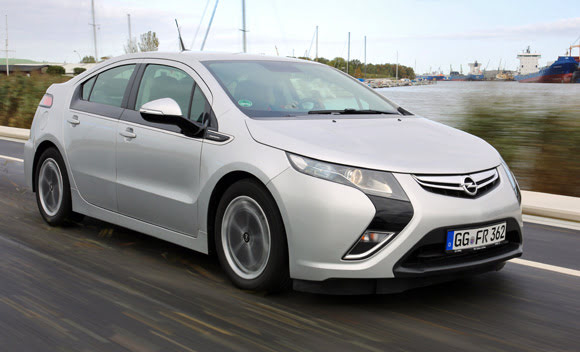
Driving at a constant speed (at 50, 100, 130 km/h): 12.69 / 20.45 / 25.86 sone* Acceleration (0–100 km/h): 15.86 sone Top speed: 36.79 sone Cobblestones (at 40 km/h): 37.03 sone Interior noise (stationary and idling): 2.60 sone Auditory perception (subjective score for noise type): Score 2- Speech intelligibility (determined at 130 km/h): Score 2* Sone is the unit of perceived loudness
Technical data
- Electric engine
- Capacity 111 kW (150 hp)
- Four-cylinder generator for range extension
- Michelin Energy Saver
- 215 / 55 R 17 H
- Acceleration 0-100 km/h in 9.7 s
- top speed 161 km/h
Conclusion Basically, the electric car presents a quieter option with a small amount of extra noise once the range extender starts working.
Score: 2
4th place Audi A3: Beautifully discreet engine
The four-cylinder can’t be heard while idling. Even under load, the accurately insulated 1.8 barely raises its voice. When accelerating, the TSI sounds sporty but not annoyingly loud. Only at higher speeds do the wind and tyre noise overtake the sound of the engine and enter the interior. It is striking that, when driving over cobblestones, the chassis hardly roars. The tyres roll very softly even on poor surfaces. As a result, the total noise level of the A3 is extremely low. Accordingly, the Sportback successfully ranks right behind the luxury sedans – and that deserves respect.
Driving at a constant speed (at 50, 100, 130 km/h): 12.77 / 18.83 / 24.75 sone* Acceleration (0–100 km/h): 23.12 sone Top speed: 59.22 sone Cobblestones (at 40 km/h): 29.34 sone Interior noise (stationary and idling): 4.74 sone Auditory perception (subjective score for noise type): Score 1 Speech intelligibility (determined at 130 km/h): Score 1-* Sone is the unit of perceived loudness
Technical data
- Four cylinder, turbo, front transverse
- Capacity 132 kW (180 hp) at 5100 / min
- Dunlop Sport Maxx RT
- 225 / 45 R 17 Y
- Acceleration 0-100 km/h in 7.2 s
- top speed 232 km/h
Conclusion The A3, especially with a TSI engine, proves that a compact car can be quiet.
Score: 2+
3rd place Bentley Mulsanne: Whispers quietly
The engine whispers quietly despite the brutal performance and sporting pedigree. And even on cobblestone roads this luxuriously insulated limousine glides gracefully. However, a slight hum from the wheel wells is clearly audible. One glance into the engine compartment reveals that the engine is completely encapsulated – not much chance of a lot of noise escaping through there. Only at full acceleration does the V8 engine finally raise its voice – a little too robustly. With such an impressive maximum speed – the car achieves nearly 300 km/h – one could wish that more of the wind noise stayed outside this luxury limo; instead it roars, despite the double-glazing.
Driving at a constant speed (at 50, 100, 130 km/h): 8.49 / 14.21 / 19.7 sone* Acceleration (0-100 km/h): 21.87 sone Top speed: 64.73 sone Cobblestones (at 40 km/h): 29.43 sone Interior noise (stationary and idling): 4.53 sone Auditory perception (subjective score for noise type): Score 1+ Speech intelligibility (determined at 130 km/h): Score 1-* Sone is the unit of perceived loudness
Technical data
- V8 twin turbo, front engine, rear drive
- Capacity: 377 kW (512 hp) at 4200 rpm
- Tyres: Dunlop SP Sport Maxx GT
- 265/40 ZR 21
- Acceleration: 0-100 km/h in 5.1 s
- Top speed: 296 km/h
Conclusion The engine shows what it can do – also acoustically. Nevertheless: the noise level in the Bentley is extremely low.
Score: 1-
2nd place Rolls-Royce Ghost: Almost complete silence
According to historical Rolls-Royce advertising, the loudest noise in the interior of the car was the ticking of the clock. Today the Rolls leaves us with a very different acoustic impression. While sprinting, the giant 570 hp engine really comes into its own and makes itself heard. However, this seems to be intentional, ensuring that customers are in no doubt that 570 hp prevail here. When the Ghost drives away at constant speed, there is almost complete silence. On cobblestones, the colossus effortlessly rolls along as expected.
The measurement microphones do detect a faint creaking from an area at the rear backrest adjustment, which does make the car feel noisy.
Driving at a constant speed (at 50, 100, 130 km/h): 9.21 / 15.34 / 21.07 sone*
Acceleration (0–100 km/h): 21.82 sone Top speed: 56.52 sone Cobblestones (at 40 km/h): 27.08 soneInterior noise (stationary and idling): 4.61 sone Auditory perception (subjective score for noise type): Score 1 Speech intelligibility (determined at 130 km/h): Score 1-* Sone is the unit of perceived loudness
Technical data
- V12 twin turbo, front engine, rear drive
- Capacity: 420 kW (570 hp) at 5250 rpm
- Tyres: Goodyear Efficient Grip
- V./h. 255/45 – 285/40 ZR 20 Y
- Acceleration: 0-100 km/h in 4.9 s
- Top speed: 250 km/h
Conclusion A travelling, peaceful oasis – as long as you don’t ask the engine to pull out all the stops. Who would do that, anyway? It’s a Rolls ...
Score: 1-
1st place Mercedes S 500 LWB: You’ll hear nothing from this purring machine
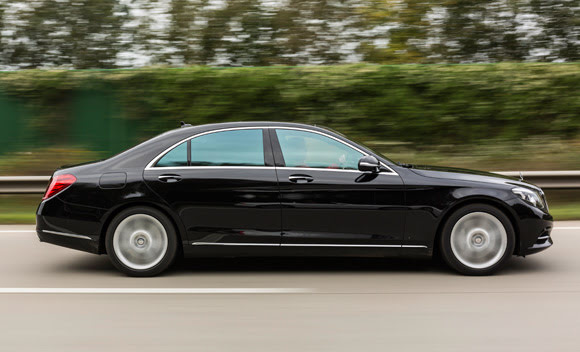
Driving at a constant speed (at 50, 100, 130 km/h): 8.47 / 14.55 / 20.51 sone *Acceleration (0–100 km/h): 20.44 sone Top speed: 45.72 sone Cobblestones (at 40 km/h): 25.27 sone Interior noise (stationary and idling): 3.81 sone Auditory perception (subjective score for noise type): Score 1 Speech intelligibility (determined at 130 km/h): Score 1-* Sone is the unit of perceived loudness
Technical data
- V8 twin turbo, front engine, rear drive
- Capacity: 335 kW (455 hp) at 5250 rpm
- Tyres: Pirelli W 240 Sottozero III
- 245/45 R 19 V
- Acceleration: 0-100 km/h in 4.8 s
- Top speed: 250 km/h
Conclusion A whispering engine and a meticulously insulated chassis – the S-Class purrs its way into first place.
Score: 1
Three quiet surprises
Precision microphones, sophisticated measuring software and attentive tester ears hear everything. Or too little, as in the case of the winner, the Mercedes S 500. The limousine marks the lower end of the current noise threshold when driving – even the Rolls Royce wasn’t quieter. The electric cars show that a silent motor alone is no guarantee for good noise comfort. Noise is also generated by wind and tyres.
Test photos courtesy of R. Rätzke, S. Krieger – AUTO BILD. Image at top courtesy of Audi.

Abonnieren Sie unseren Newsletter zum Thema Schall und Schwingung


